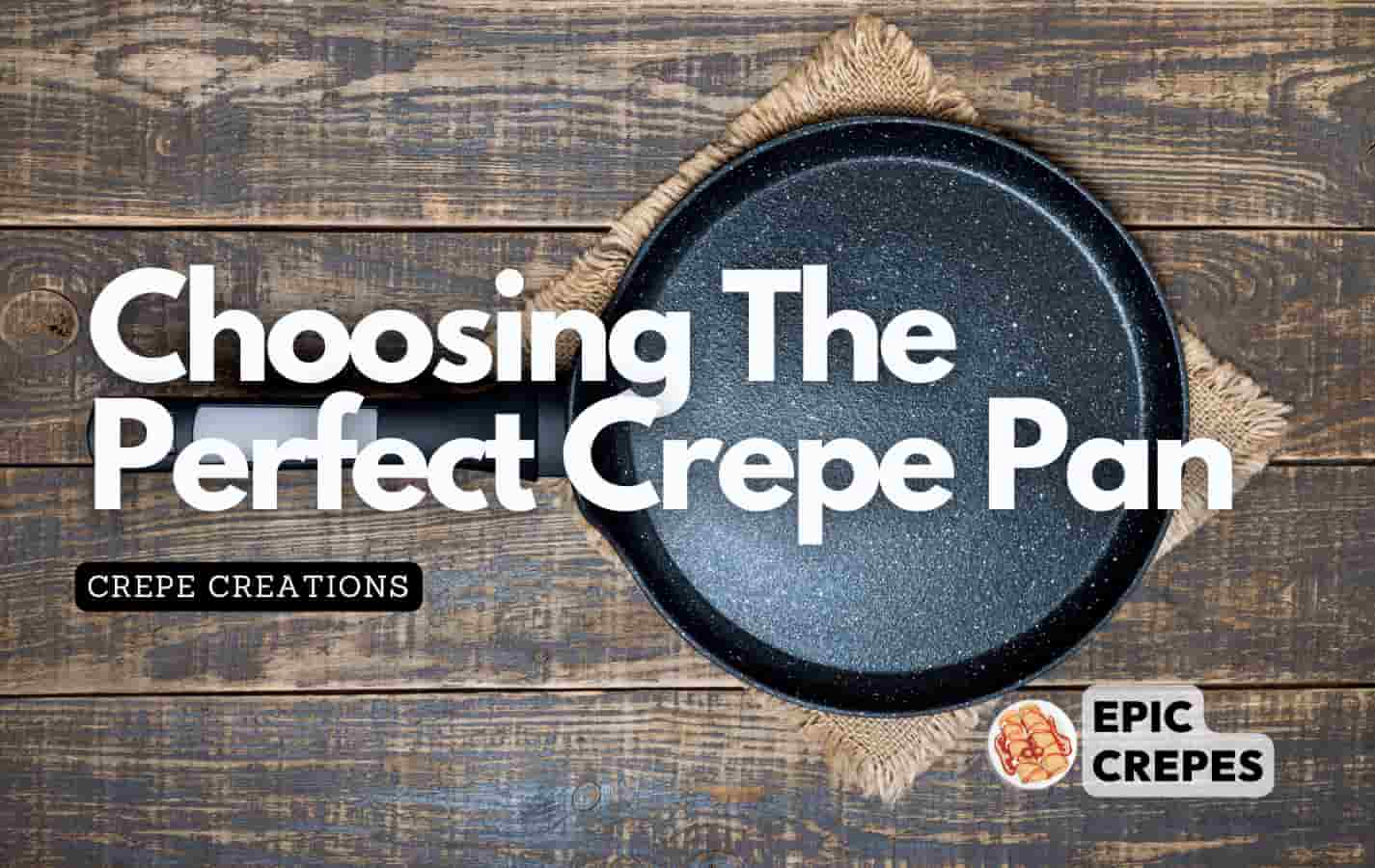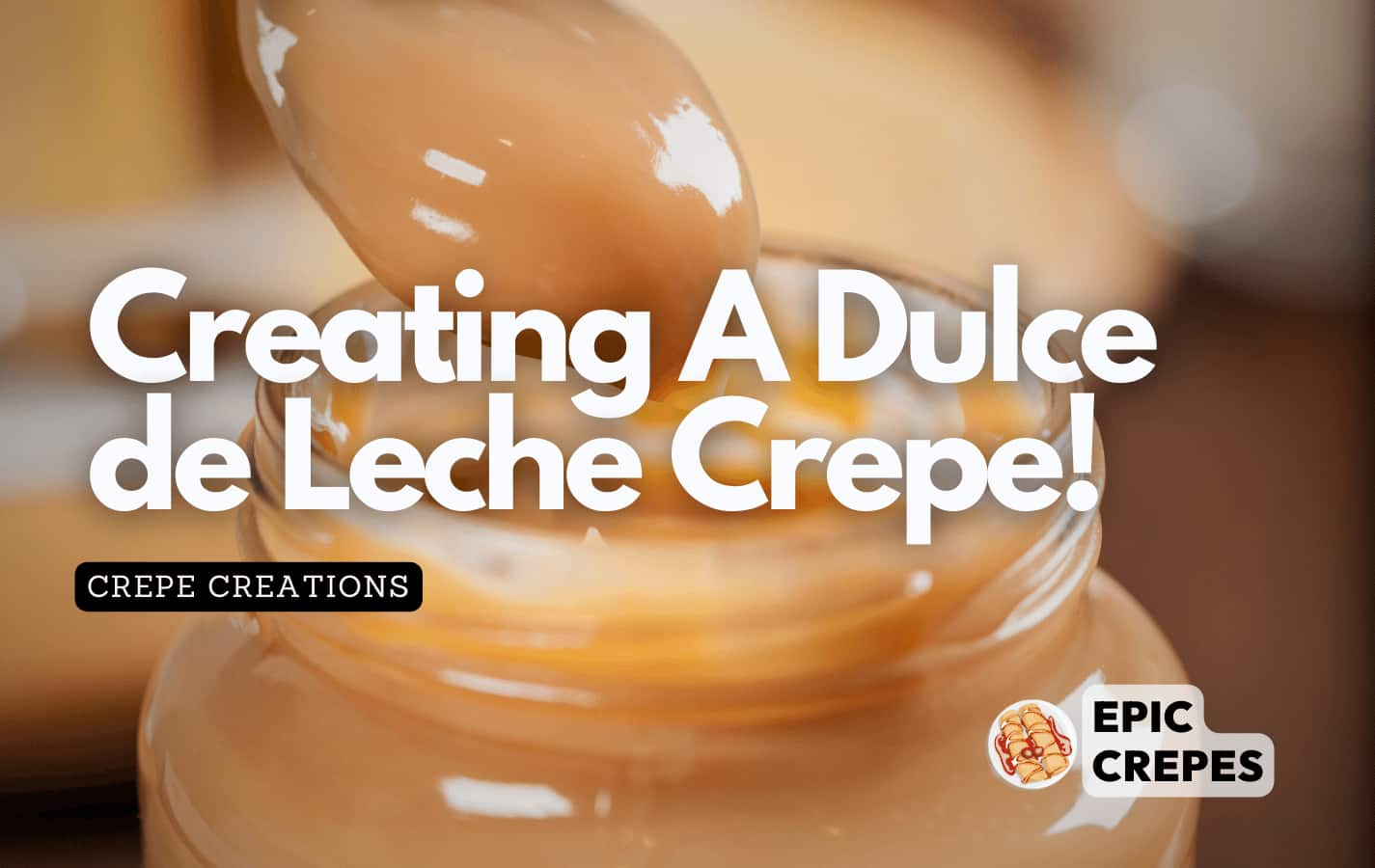If you are a fan of French cuisine, then you must be familiar with crepes. Crepes are thin, delicate pancakes that can be enjoyed in both sweet and savory versions. They are versatile and can be filled with a variety of ingredients, making them a popular choice for breakfast, lunch, or even dessert.
However, to make perfect crepes at home, you need the right tool – a crepe pan. Choosing the right crepe pan can be a daunting task since there is an overwhelming number of options available in the market. From cast iron and non-stick to electric and traditional style pans, it’s easy to get confused about which one to pick.
In this article, we’ll provide you with a comprehensive buying guide for crepe pans so that you can choose the best one for your needs and budget.
Size Matters: Choosing The Right Diameter
Have you ever heard the saying, ‘size doesn’t matter’? Well, when it comes to choosing a crepe pan, that couldn’t be further from the truth. The size of your pan will impact how many crepes you can make at once, and ultimately affect your overall cooking experience.
Before deciding on the perfect diameter for your crepe pan, consider a few things. First and foremost, think about where you plan to store it. If you have limited cabinet space or want to display your new pan on a shelf, a smaller diameter may be more practical. Additionally, keep in mind that larger pans require more storage space and can be heavy and cumbersome to maneuver.
Another important factor to consider is cooking temperature. A larger diameter pan means a larger surface area which can lead to uneven heat distribution if not properly managed. Make sure to take note of the recommended cooking temperature for your specific pan size before starting your recipe.
When it comes down to it, the ideal diameter for your crepe pan will depend on personal preference and cooking needs. However, by taking into account factors such as crepe pan storage and cooking temperature, you’ll be well on your way to selecting the perfect size for your kitchen arsenal.
In the next section, we’ll dive into material matters: nonstick vs. cast iron vs. stainless steel – another crucial aspect in choosing the best crepe pan for you!
Material Matters: Nonstick Vs. Cast Iron Vs. Stainless Steel
Now that you’ve chosen the perfect size for your crepe pan, it’s time to consider the material. The material of your crepe pan can have a significant impact on its durability and performance.
There are three main materials to choose from: nonstick, cast iron, and stainless steel.
Nonstick pans are a popular choice because they make cooking and cleaning up a breeze. However, they tend to have a shorter lifespan than other materials and can scratch easily if not cared for properly.
Cast iron pans are incredibly durable and offer excellent heat retention, but they require more maintenance and seasoning to prevent rusting.
Stainless steel pans are also durable and low-maintenance, but they don’t offer the same level of nonstick properties as their counterparts.
Caring for your crepe pan is essential regardless of the material you choose. Make sure to follow the manufacturer’s instructions for cleaning and storage to ensure that your pan lasts as long as possible. With proper care, you can expect your crepe pan to last for many years to come.
When it comes to choosing between a round or square shape for your crepe pan, there are a few things to consider. Round pans are more traditional and may be easier to find in stores. They also allow for more even cooking since the batter spreads out evenly across the surface.
Square pans may be better suited for those who want larger portions or prefer a unique presentation with straight edges. Ultimately, it comes down to personal preference and what will work best for your cooking needs.
Shape Matters: Round Vs. Square
You may be wondering, ‘Why does the shape of a crepe pan matter?’ Well, let me tell you, it can make all the difference in your crepe-making success.
Round and square pans both have their advantages and disadvantages. However, one factor that many people overlook is the ease of flipping.
Round pans are often the go-to choice for traditional French crepes because they allow for easy swirling of batter and even cooking. However, when it comes to flipping stuffed crepes or omelets, a square pan may be more beneficial.
The straight edges provide a barrier to keep fillings in place while flipping. This means less mess and frustration in the kitchen.
In addition to easier flipping for stuffed crepes, a square pan also has practical benefits. The corners of a square pan provide extra surface area for cooking multiple crepes at once, saving time and energy. Plus, they tend to have higher sides than round pans, reducing spills and splatters.
Consider investing in a square crepe pan if you plan on making more than just traditional French-style crepes. When choosing between round and square pans, consider what type of crepes you will be making and how important ease of flipping is to you.
Remember that there are benefits to both shapes depending on your needs. Now that we’ve covered shape matters, let’s move on to handle matters: stay-cool vs removable handles.
Handle Matters: Stay-Cool Vs. Removable
Stay-cool handles are a popular feature amongst crepe pans. The benefits of stay cool handles include the fact that they can be touched without the need for oven mitts, making it easier to maneuver the pan while cooking. Additionally, these types of handles are typically made from materials such as silicone or rubber, which provide a comfortable grip.
On the other hand, some crepe pans come equipped with removable handles. While this may seem like a convenient option, there are both pros and cons to consider.
One benefit is that the pan can be stored more easily in smaller spaces with the handle detached. However, removing and reattaching the handle can be cumbersome and time-consuming.
Another potential issue with removable handles is their durability. These types of handles may not hold up as well over time compared to stay-cool handles that are permanently attached to the pan.
It’s important to weigh these factors when deciding whether or not to purchase a crepe pan with a removable handle. When it comes to choosing between stay-cool and removable handles for your crepe pan, it ultimately comes down to personal preference and cooking needs.
However, if you’re looking for convenience and durability in your cookware, stay-cool handles may be the better choice. In the next section, we’ll discuss another important aspect of crepe pans: rim matters and whether flared or straight rims are better suited for your cooking style.
Rim Matters: Flared Vs. Straight
You may be thinking, ‘What does the shape of the rim have to do with making crepes?’ Well, it actually matters quite a bit. When it comes to flared vs straight rims on crepe pans, the main consideration is how easy it is to flip your crepes.
A flared rim allows for more room to maneuver your spatula underneath the crepe, making it easier to flip without tearing. However, there is another factor to consider when choosing between flared and straight rims: rim height.
A higher rim can help contain the batter and prevent it from spreading too thin, resulting in a thicker crepe. This can be especially helpful for beginners who may struggle with getting their crepes just right. Ultimately, whether you go with a flared or straight rim depends on your personal preference and level of experience.
If you’re new to crepe making or tend to struggle with flipping delicate foods, a pan with a flared rim may be a better choice. But if you’re confident in your flipping skills and prefer thinner crepes, a pan with a straighter rim and lower height may be more your speed.
Now let’s move on to another important aspect of choosing the right crepe pan: thickness matters – thin vs thick.
Thickness Matters: Thin Vs. Thick
When it comes to crepe pans, thickness matters a great deal.
A thin pan heats up quickly, which is advantageous if you’re in a hurry. However, it also means that the pan loses heat fast, which can be a drawback when cooking crepes that require even and consistent heat throughout the process.
On the other hand, a thick pan takes longer to heat up but retains the heat better. This means that you can cook crepes evenly without worrying about hot spots or fluctuating temperatures.
The downside of thicker pans is that they tend to be heavier than their thinner counterparts, which may be an issue for some home cooks.
Ultimately, choosing between thin and thick pans comes down to personal preference and cooking style.
If you need a pan that heats up quickly and you don’t mind keeping an eye on the temperature, then a thin pan might work well for you. However, if you want a more reliable and consistent cooking experience with minimal fuss, then investing in a thicker crepe pan might be worth considering.
As we’ve seen, there are benefits and drawbacks to both thin and thick crepe pans when it comes to heating time versus temperature retention.
The next section will consider how weight matters when choosing the right crepe pan for your needs.
Weight Matters: Light Vs. Heavy
Now that we’ve discussed the importance of thickness, let’s move on to another factor: weight. When it comes to crepe pans, you’ll find both light and heavy options on the market. Each has its own benefits, so it’s important to consider what you’re looking for in a pan.
Lightweight pans are easy to handle and can be great for beginners or those with weaker wrists. They also heat up quickly, which can be a plus if you’re short on time. However, they may not be as durable as heavier pans and can sometimes have hot spots where the batter cooks unevenly.
On the other hand, heavy pans tend to be more durable and offer better heat distribution. They may take longer to heat up, but they hold onto that heat well once they do.
When it comes to durability comparison between light and heavy pans, it’s important to note that heavier doesn’t always mean better quality. Make sure to read reviews and do your research before investing in a heavier pan just because you assume it will last longer.
That being said, if you plan on using your crepe pan frequently or for commercial purposes, a heavier option may be worth considering. Heat distribution is another key factor when choosing between light and heavy crepe pans.
If even cooking is important to you (and it should be!), then a heavier pan will likely offer better results. However, if you’re willing to adjust your cooking techniques slightly or prefer a quicker cook time, then a lighter pan could work just fine.
As we continue through this buying guide, we’ll discuss one final factor to consider: price matters. Finding the best value for your budget is essential when making any purchase – including a crepe pan!
Price Matters: Finding The Best Value
If you’re looking to buy a crepe pan, it’s important to consider your budget. You don’t have to break the bank to find a quality crepe pan, but you also don’t want to sacrifice quality for price.
Comparing features and prices of different brands can help you find the best value for your money. One way to find discounts on crepe pans is by checking online retailers such as Amazon or eBay. They often have sales and promotions that can help you save money on your purchase.
Another option is waiting for seasonal sales such as Black Friday or Cyber Monday, where many stores offer discounts on kitchenware. Remember that buying a cheap crepe pan may end up costing you more in the long run if it doesn’t last or doesn’t perform well.
So, while price matters, it’s essential not to compromise on quality. In the next section, we’ll discuss how brand matters when it comes to crepe pans’ quality and reputation.
Brand Matters: Quality And Reputation
When purchasing a crepe pan, the brand you choose matters. Quality assurance and customer satisfaction are essential factors that must be taken into consideration. Brands that have a good reputation in the market offer products that are durable, reliable, and provide excellent performance.
A reputable brand ensures high-quality standards of their products by using premium-grade materials in manufacturing. These materials make their product non-toxic, free from harmful chemicals, and safe for food preparation. In addition, they conduct rigorous quality checks to make sure their products meet safety requirements and perform optimally.
Customer satisfaction is also a key factor in choosing a brand. A company with an excellent reputation frequently will offer outstanding customer service before and after purchase.
They provide warranties, money-back guarantees or exchange policies for any defects or issues consumers encounter.
To choose the best brand for your crepe pan, look for those trusted by professional chefs. Check online reviews and ratings from customers who have already purchased the product. Opt for brands that offer warranties, money-back guarantees or exchange policies.
Moving onto maintenance matters: cleaning and care…
Maintenance Matters: Cleaning And Care
Taking good care of your crepe pan is essential to its longevity and performance. Proper cleaning and maintenance can prevent rust from forming, ensuring that your pan stays in excellent condition for years to come.
To prevent rust, it’s important to clean your crepe pan after each use thoroughly. Use a soft sponge or cloth with warm water and mild dish soap to remove any food residue or grease. Do not use abrasive materials such as steel wool or harsh chemicals as they can damage the non-stick coating on the pan. After washing, dry the pan completely before storing it away.
Investing in quality cleaning products can help keep your crepe pan looking like new. Look for gentle cleaners specially formulated for non-stick surfaces to avoid scratching or damaging the finish. Some popular options include vinegar, baking soda, and lemon juice. Regularly applying a thin layer of cooking oil or seasoning your pan can also help maintain its non-stick properties.
Maintaining your crepe pan does not have to be a hassle. By taking simple steps like preventing rust and using the best cleaning products available, you can ensure that your pan remains in top condition for years to come.
In the next section, we’ll discuss compatibility matters when it comes to choosing between electric and gas stoves for your crepe pan.
Compatibility Matters: Electric Vs. Gas Stove
When it comes to purchasing a crepe pan, one important factor to consider is whether the pan is compatible with your stove type. There are two main types of stoves: electric and gas. Each type has its own pros and cons when it comes to using a crepe pan.
If you have an electric stove, you’ll want to look for a crepe pan that has a flat bottom and heats evenly. This will ensure that your crepes cook evenly and don’t stick to the pan. One potential downside of using a crepe pan on an electric stove is that the heat may not be as responsive as it would be on a gas stove, which can make it more difficult to control the temperature.
On the other hand, if you have a gas stove, you can use any type of crepe pan without worrying about compatibility issues. Gas stoves provide more responsive heat control than electric stoves, which makes it easier to cook perfect crepes every time. However, because gas stoves produce an open flame, there are additional safety precautions that need to be taken when using a crepe pan.
Pros and Cons:
- Electric Stove
- Pros:
- Even heating
- No open flame
- Cons:
- Less responsive heat control
- May require specific type of pan
- Gas Stove
- Pros:
- Responsive heat control
- Can use any type of pan
- Cons:
- Open flame requires additional safety precautions
- May not heat as evenly as electric
Safety Precautions:
- Use caution when cooking over an open flame.
- Keep loose clothing and long hair away from the stove.
- Use appropriate-sized pans to prevent flames from reaching beyond the burner.
- Turn off burners immediately after use.
In summary, when choosing a crepe pan, it’s important to consider the compatibility with your stove type. Electric stoves require a specific type of pan, while gas stoves can use any pan. However, additional safety precautions need to be taken when using a crepe pan on a gas stove due to the open flame. With proper precautions and attention, you can enjoy delicious crepes on both types of stoves.
When it comes to making perfect crepes, accessories matter: spatulas, spreaders, and more.
Accessories Matter: Spatulas, Spreaders, And More
Accessories Matter: Spatulas, Spreaders, and More
If you think that buying a crepe pan is enough to make perfect crepes, then you’re wrong. A good crepe pan should come with high-quality accessories that will help you create the perfect crepe every time. The right spatula and spreader can make all the difference in your crepe-making experience.
Spatula types vary depending on their materials and shapes. For example, silicone spatulas are great for non-stick pans as they won’t scratch the surface. On the other hand, wooden spatulas are ideal for cast iron pans as they won’t conduct heat and burn your hands. When choosing a spatula, consider its flexibility and width. A flexible spatula can easily slide under a delicate crepe without damaging it while a wide one can flip your crepes with ease.
Spreaders styles also play an important role in making perfect crepes. There are different spreader styles available on the market like T-shaped or V-shaped spreaders. T-shaped spreaders are more versatile as they can be used to spread batter evenly across the pan’s surface regardless of its size. V-shaped spreaders are ideal for small-sized pans as they allow bakers to reach every corner of the pan easily.
When it comes to creating perfect crepes, having the right accessories is key. Keep in mind that not all spatulas and spreaders are created equal, so choose wisely based on your needs and preferences.
In the next section, we’ll discuss how reviews matter when buying a crepe pan and its accessories so you can learn from other buyers’ experiences before making your purchase decision.
Reviews Matter: Learning From Other Buyers
The Importance of feedback cannot be overstated when it comes to buying a crepe pan. In fact, it is one of the most critical factors to consider. Reviews from other buyers can provide valuable insights into the quality and performance of a particular crepe pan.
Therefore, before making your final decision, take some time to read through various reviews online.
Trusting online reviews can be daunting, especially with so many fake reviews out there. However, there are ways to distinguish genuine reviews from fake ones. For instance, look for reviews that provide detailed information about the product’s features and performance. Genuine reviewers will also share both their positive and negative experiences with the product.
Reading reviews can save you a lot of time and money in the long run. By learning from other buyers’ experiences, you can make an informed decision on which crepe pan to buy. So be sure to read through as many reviews as possible before making your final decision on which crepe pan to purchase.
Conclusion: Making Your Final Decision
After reading through various reviews, you may have a better idea of what features are important to you in a crepe pan. Now it’s time to start comparing those features among the options available.
Consider the size, material, and non-stick coating of each pan, as well as any additional accessories or features that may come with it.
As you weigh your options, don’t forget to also consider your budget. It’s easy to get swept up in all the bells and whistles of a high-end crepe pan, but if it doesn’t fit within your price range, it’s not worth it. Look for pans that offer the features you want at a price point that works for you.
Ultimately, when making your final decision, choose the crepe pan that best fits your needs and preferences. Remember that everyone’s cooking style is different, so what works for someone else may not work for you. Trust your instincts and go with the option that feels right – after all, this crepe pan will be a staple in your kitchen for years to come.
Frequently Asked Questions
What Is The Difference Between A Crepe Pan And A Regular Frying Pan?
The difference between a crepe pan and a regular frying pan lies in their design and functionality.
Crepe pans are typically made of materials that conduct heat evenly such as cast iron or non-stick coatings, allowing for the delicate crepes to cook evenly without sticking. The best crepe pan brands include De Buyer, Mauviel, and T-fal.
Regular frying pans, on the other hand, come in a variety of sizes and materials and are designed for general cooking purposes. While some may argue that a regular frying pan can be used to make crepes, it is not recommended as it may result in uneven cooking or sticking.
If you want perfectly cooked crepes every time, investing in a high-quality crepe pan is the way to go.
Are There Any Health Concerns With Using Nonstick Crepe Pans?
There may be some health concerns with using nonstick crepe pans.
The coating used in nonstick pans can release toxic fumes when heated to high temperatures, which can be harmful to humans and pets.
However, there are alternative cookware options available such as ceramic or cast iron crepe pans that do not use the same nonstick coating.
It’s important to note that these alternatives may require a bit more oil or butter for cooking, but they are generally considered safer than traditional nonstick pans.
If you’re looking for crepe pan alternatives, consider exploring these options to ensure your safety in the kitchen.
Can A Crepe Pan Be Used For Other Types Of Cooking?
Looking for a versatile cookware option that can handle more than just crepes?
Well, have we got news for you! A crepe pan isn’t just limited to whipping up deliciously thin pancakes.
In fact, it’s one of the most versatile options in your kitchen arsenal. With endless alternative uses, from sauteing veggies to frying eggs, this pan is a game-changer for any home cook looking to expand their culinary horizons.
So why limit yourself when you have so many versatility options at your fingertips?
Let your creativity run wild with a crepe pan and see what other delicious dishes you can whip up!
How Long Should A Crepe Pan Last With Proper Maintenance?
With proper maintenance tips, a crepe pan should last for years.
The durability of a crepe pan largely depends on how well it is taken care of.
To ensure its longevity, avoid using metal utensils which can scratch the surface and always clean the pan gently with warm soapy water.
Non-stick pans require extra care since the coating can easily get damaged if not handled properly.
Additionally, storing the crepe pan properly is also important to prevent any damage or warping.
With these maintenance tips in mind, your crepe pan should last you for many delicious pancakes to come!
Can A Crepe Pan Be Used On An Induction Stove?
Induction compatibility is a crucial factor to consider when choosing a cookware item, especially if you own an induction stove.
Before investing in a new crepe pan, make sure it is compatible with your cooking surface options. Some pans are specifically designed for induction stovetops, while others may not work at all.
It’s important to do your research and choose a pan that will work seamlessly with your kitchen appliances. With the right crepe pan, you can enjoy delicious homemade crepes without any hassle or frustration.
Conclusion
In conclusion, if you’re a fan of crepes, investing in a dedicated crepe pan can make all the difference in your cooking experience. With its shallow edges and nonstick surface, you’ll be able to create perfectly thin and delicate crepes every time. And don’t worry about health concerns – just make sure to choose a high-quality nonstick coating that is free of PFOAs.
But don’t let your crepe pan go to waste when you’re not whipping up breakfast delicacies. With its versatility, you can use it for other types of cooking as well, from omelets to pancakes to even searing meats.
Just remember to take good care of it with proper maintenance and cleaning, and it should last for years to come.
So go ahead, indulge in some crepe-making magic and add a touch of French elegance to your kitchen repertoire!




